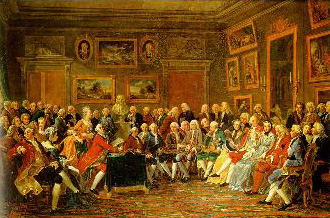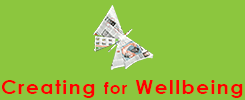Opening to Collaboration
Opening to Collaboration The Snakes & Ladders of Learning New Leaf, Old Leaf The Nest Le Salon
Le Salon
The practice of Le Salon can be a fascinating and effective experience in learning to listen and learning to be. Both of these qualities have been remarked upon by artists as being central to working creatively and collaboratively. It is difficult to describe the effect of participating in Le Salon; we invite you to try!
The description and approach to le Salon that we have used in the ATP was introduced to us by Ralph Kerle, Executive Chairman of The Creative Leadership Forum and Founder of the Creative Skills Training Council, Asia Pacific. What is presented here is a very potted history of “Le Salon”, as well as guidelines outlined by Ralph Kerle in how he facilitates this activity.
Brief History of Salons
What comes to mind when you think of “Le Salon”? Perhaps the cosmopolitanism, intrigue and brilliance of pre-Enlightenment Paris, or the high-society soirees woven through Tolstoy’s War and Peace? A gathering of people alive with ideas, keen to share them and to listen and come away enriched and – yes – enlightened.
Conversational salons are probably most associated today with Parisian intellectuals from the 17th and 18th Centuries, when like- and literary-minded people would gather to exchange ideas and engage in the art of conversation.
The wives of wealthy aristocrats became famous (and infamous) for hosting salons, by inviting upcoming thinkers, poets, philosophers, and musicians into their homes and encouraging the exchange of news and ideas.
While informal, these gatherings were later recognised as playing a vital role in the emergence of the Age of Enlightenment. Certainly “les salons” were a significant part of aristocratic French society at that time, but informal, moderated conversational gatherings were taking place long before this time (sources date them back to Ancient Greece) and continued long afterwards: in Paris in the 1920s, writer Gertrude Stein brought together thinkers, writers and painters such as Matisse and Picasso to discuss their work and the world of art and literature – conversations that shaped the influential Modernist movement.

Salons Here and Now
Salons are still places to incubate ideas, to discuss the human condition and to encourage and increase knowledge and understanding.
Ralph Kerle uses a salon format to facilitate group conversations in an enriching and respectful way. His format offers a great way of slowing down and allowing individual and collective thoughts to be formulated, ruminated and shared.
Ralph suggests that the conversations could be any length, that they play out until they come to a natural finish, or a specific time limit (90 minutes, for example) can be set.
As moderator, Ralph introduces his salons by creating a gentle structure and outlining a series of important protocols. He takes participants through a short meditation, after which the conversation can occur …
“Let’s set the scene, the atmosphere and the space. Close the curtains so there is no exterior light and let’s begin…
I would like us to begin by having a simple conversation – a conversation without a topic, without a frame – a conversation amongst strangers that is in the moment and of the moment… there are only a couple of simple protocols in these conversations that we need to observe…
The conversation has a beginning and an end – like life…
The conversation has some important protocols:
- Speak whenever you are ready, at any time, on any topic
- We wait until one person has completed speaking, and then we allow a pause before the next person speaks. I emphasise pause…
- There must be no note taking.
During the course of the conversation:
- observe your mind working
- observe your physical being
- observe your reactions to the person speaking
- Make yourself comfortable.”

Using Le Salon in the Artists Training Program
In practicing Le Salon as a group exercise for 8 or 15 participants, our experience has been an increased openness to new perspectives and a willingness to let go of fixed positions. Arts, education and health professionals who have participated in this activity at the start of training days have found it a great way to prepare for exploring new ways of understanding, working and relating.
Acknowledgment
This description of Le Salon activity was written by Pia Smith.
